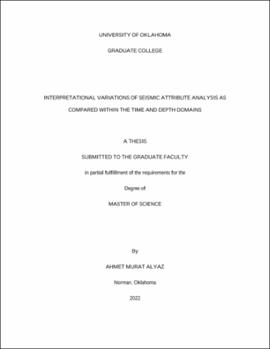| dc.description.abstract | Migration is one of the crucial data processing steps re-locating the recorded seismic events to their true locations, suppressing the diffractions and thus, providing more accurate imaging of the subsurface. It can be applied in the time or depth domain depending on the geologic characteristics of the study area. The time migration algorithm provides a quality imaging of subsurface geology in the areas characterized by intense faulting and complex geologic structures exhibiting sharp dips. However, since the time migration method assumes only mild lateral velocity variations and provides more vertical rather than lateral resolution, in the presence of high lateral velocity contrasts, this approach distorts the imaging quality by creating false geometric constructions such as fault shadows. Therefore, in such areas, depth migration, which has high lateral resolution and is less sensitive to lateral velocity contrasts, is applied to seismic data. Despite such advantages of the depth migration method, there are geometrical and physical variations that might affect the seismic interpretation of the structural and stratigraphic events like faults and channels between both domains worth studying. To analyze these differences, the Taranaki Basin, offshore New Zealand, which exhibits intense faulting and numerous paleochannels, was selected and the Toro 3-D Seismic Survey containing the pre-stack time (PSTM) and depth (PSDM) datasets were used. Unlike previous studies focused on detecting and removing the pitfalls and artifacts generally occurring after depth conversion of the time data or directly observed in the depth-migrated seismic data and as a result, distorting the imaging of the subsurface, even creating fake structures, this research analyzed the variations affecting seismic interpretation between the PSTM and PSDM datasets by using geometrical, physical, and spectral decomposition attributes. This thesis creates awareness for the interpreters by supplying new insights showing how the interpretation of structural (faults) and stratigraphic elements (channels) are changing geometrically (wide, length, and depth) or physically (amplitude, phase, and frequency). In addition, this work helps decision-makers avoid the increase in exploration studies, seismic risk assessments and drilling costs that might be caused by misinterpretations of the events. To make a comprehensive comparison, the hypothetic models reflecting the expectations were created for each attribute and both qualitative and quantitative interpretations were provided about the findings. The results of the comparisons indicated that the dip angle of the faults increased significantly, the angle of the channel walls are become steeper and more curved, and bodies formed narrower shapes in the depth-migrated data. The observations also showed that there are amplitude and phase variations within and surroundings of the channels which means different lithologic characteristics between both domains. The multispectral coherence analysis demonstrated frequency variations in the channel edges. Despite many limitations like the lack of borehole data in the 3D area, using only four normal faults and three different types of channels formed in the same formation (the Giant Foresets Formation), this study provides useful results to understand what interpretational variations can lead to. | en_US |
